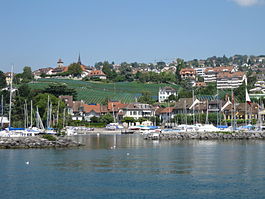Pully
| Pully | ||
|---|---|---|

Pully lake front
|
||
|
||
| Coordinates: 46°31′N 6°40′E / 46.517°N 6.667°ECoordinates: 46°31′N 6°40′E / 46.517°N 6.667°E | ||
| Country | Switzerland | |
| Canton | Vaud | |
| District | Lavaux-Oron | |
| Government | ||
| • Mayor |
Syndic Gil Reichen |
|
| Area | ||
| • Total | 5.85 km2 (2.26 sq mi) | |
| Elevation | 426 m (1,398 ft) | |
| Highest elevation | 800 m (2,600 ft) | |
| Lowest elevation (Lake Geneva) | 375 m (1,230 ft) | |
| Population (Dec 2015) | ||
| • Total | 17,807 | |
| • Density | 3,000/km2 (7,900/sq mi) | |
| Postal code | 1009 | |
| SFOS number | 5590 | |
| Surrounded by | Belmont-sur-Lausanne, Lausanne, Lugrin (FR-74), Paudex, Savigny | |
| Twin towns | Obernai (France) | |
| Website |
www Profile (French), SFSO statistics |
|
Pully (French pronunciation: [pyˈji]) is a municipality in Switzerland in the canton of Vaud, located in the district of Lavaux-Oron.
It is one of the eastern suburbs of the city of Lausanne, located on the shores of Lake Geneva (Lac Léman) and at the foot of the vineyards of Lavaux on the road to Vevey and Montreux.
Pully is first mentioned in 994 as Pulliacum.
In 1826 a neolithic cemetery with about 30 graves was uncovered at Pierra-Portray. However, the artifacts were not fully preserved and only one flint blade and a soapstone fragment still exist. Near Pierra-Portray, along the Chemin de Chamblandes, Albert Naef examined 23 tombs in 1901-10. These tombs belonging to a similar set of tombs which were sporadically excavated and recorded between 1880-1993. The local rectangular graves consisted of boxes assembled from four vertical slabs of about 1 meter (3.3 ft) in length, with a fifth plate that served as a lid. The dead were lying on their left side with their legs drawn up to the chest and the head pointed to the east. The largest find of stone box graves in Pully was the cemetery at Chamblandes. Due to the number of finds at Chamblandes, all similar cist or stone box graves in the surrounding area came to be known as Chamblandes type graves. The cemetery of Chamblandes extends over a length of about a hundred meters (yards) and included 76 graves and over 100 skeletons. This Middle Neolithic (4300-3900 BC) graveyard included as grave goods; ocher, various commodities (polished stone ax) and jewelry (wild boar tusks, pendants made of shells, coral and lignite). Two collars, one needle, a dagger and a bronze knife-blade hatchet are attributed to an early Bronze Age grave. In 1992 a cremation grave was discovered that dated from the Late Bronze Age.
...
Wikipedia



